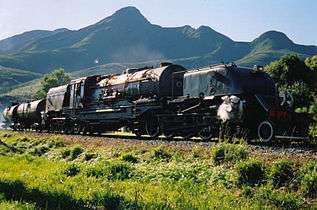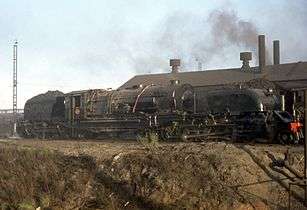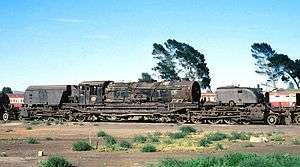South African Class GO 4-8-2+2-8-4
|
No. 2592 staged at De Aar, 14 November 1979 | |||||||||||||||||||||||||||||||||||||||||||||||||||||||||||||||||||||||||||||||||||||||||||||||||||||||||||||||||||||||||||||
| |||||||||||||||||||||||||||||||||||||||||||||||||||||||||||||||||||||||||||||||||||||||||||||||||||||||||||||||||||||||||||||
| |||||||||||||||||||||||||||||||||||||||||||||||||||||||||||||||||||||||||||||||||||||||||||||||||||||||||||||||||||||||||||||
| |||||||||||||||||||||||||||||||||||||||||||||||||||||||||||||||||||||||||||||||||||||||||||||||||||||||||||||||||||||||||||||
| |||||||||||||||||||||||||||||||||||||||||||||||||||||||||||||||||||||||||||||||||||||||||||||||||||||||||||||||||||||||||||||
The South African Railways Class GO 4-8-2+2-8-4 of 1954 was an articulated steam locomotive.
In 1954, the South African Railways placed 25 Class GO light branchline tank-and-tender Garratt articulated steam locomotives with a 4-8-2+2-8-4 Double Mountain type wheel arrangement in service. It was the last new steam locomotive type to be acquired by the Railways.[1][2][3]
Manufacturer

The Class GO 4-8-2+2-8-4 tank-and-tender Garratt locomotive was designed to operate on lighter rails. The designs were prepared in 1952 under the supervision of L.C. Grubb, the Chief Mechanical Engineer (CME) of the SAR from 1949 to 1954, and an order for 25 of these locomotives was placed with Henschel and Son in Germany. Their construction immediately followed that of the first batch of the Class GMA Garratt, which was built by the same manufacturer.[1][4][5]
They were built in 1953 and were delivered and placed in service in 1954, numbered in the range from 2572 to 2596. The Class GO turned out to be the last new steam locomotive type to be acquired by the Railways before full-scale electrification and dieselisation commenced. The Class 5E mainline electric locomotive entered service a year after the Class GO, and the Class 31-000 diesel-electric locomotive in 1958.[3]
Characteristics
In design and general appearance, the Class GO was very similar to the Class GMA and many parts were interchangeable. It was also superheated, with a mechanical stoker, Walschaerts valve gear and piston valves, and was built on an identical one-piece Commonwealth cast steel frame. The chief differences were aimed at reducing weight, such as a smaller boiler with a reduced diameter, a smaller firebox and firegrate area and a half ton smaller capacity coal bunker.[1][3][6][7]
The boiler was of telescopic construction, with an inside diameter of 6 feet 2 3⁄4 inches (1,899 millimetres) at the first ring and 6 feet 4 1⁄8 inches (1,934 millimetres) at the firebox end. As a result of the smaller diameter boiler, the Class GO had a slightly longer chimney than the Class GMA. On the coal bunker, the reduced capacity involved altering the inverted "L" front end profile of the Class GMA bunker to a "\" profile on the Class GO bunker, as well as lowering the bunker height from more or less in line with the cab roof on the Class GMA to somewhat below the cab roofline on the Class GO.[1]
The engine units were identical to those of the Class GMA, except that the cylinders were lined and sleeved to reduce the bore from 20 1⁄2 to 18 1⁄2 inches (521 to 470 millimetres) to suit the smaller boiler. This resulted in a correspondingly reduced tractive effort, from 60,700 to 49,430 pounds-force (270.0 to 219.9 kilonewtons) at 75% of boiler pressure. It had roller bearing axle boxes on all wheels, but not on the crank-pins, and cannon boxes on all axles except those of the inner Bissel trucks, which had outside bearings.[1][3][6][7]
.jpg)
Like the Classes GM and GMA, the Class GO was a tank-and-tender Garratt. As was done with the Class GM and Class GMA, the Class GO carried water only in its front tank, while the rear bunker carried only coal. The meagre water supply was augmented by semi-permanently coupling a purpose-built Type X-17 water tender with a capacity of 6,815 imperial gallons (31,000 litres) to the locomotive. The Class GO and the first batch of the Class GMA were both equipped with the second version of the Type X-17 water tender which was built in 1953.[1]
To minimise rail stress, coupled wheel balancing was arranged to limit the hammer blow effect to a maximum of one ton per wheel at 45 miles per hour (72 kilometres per hour). The end result was a locomotive with a maximum axle load of 13 long tons 8 hundredweight (13,620 kilograms) which could operate on 45 pounds per yard (22 kilograms per metre) rails. It could negotiate curves of 275 feet (84 metres) radius with a gauge widening of not more than 3⁄4 inch (19 millimetres) and a superelevation of 4 1⁄2 inches (114 millimetres).[1][3][6][7]
The most obvious visible differences between the Class GMA and Class GO were their coal bunker front ends, with the inverted "L" profile of the Class GMA and the "\" profile of the Class GO, and the longer chimney of the Class GO. On both locomotives, the engines for their mechanical stokers were situated in the cutout on the front or cabside ends of their coal bunkers, but on the right or driver's side on the Class GMA and on the left or fireman's side on the Class GO.[1]
Service
Upon delivery, they were briefly put to work on the line from Krugersdorp to Zeerust, after which they were relocated to the line from Belfast to Steelpoort in the Eastern Transvaal, shedded at Lydenburg. This is one of the toughest lines on the SAR with a ruling gradient of 1 in 33 (3%), which climbs in 95 miles (153 kilometres) from a nadir at an altitude of 2,427 feet (740 metres) to the summit at Nederhorst at 6,875 feet (2,096 metres), the highest point on the SAR.[3][7]
When the Steelpoort line was dieselised in 1972, they went to work on the branchline from Umtata to Amabele in Transkei and on the Greytown branchline out of Pietermaritzburg in Natal. They were unpopular in Transkei, however, being too small to replace two Class 14CRB locomotives, while their coupled wheelbase per engine unit was longer than that of the Class 14CRB and therefore took less kindly to the sharp curves at the Kei River crossing.[7]
As a result, the Transkei locomotives were soon also relocated to Natal, where most of them ended up on the North Coast line, shedded at Stanger, Empangeni and Gingindlovu. From Empangeni, they also worked the line to Golela on the Swaziland border, and they also served briefly on the Eshowe and Nkwalini branchlines. They were soon withdrawn from the Eshowe branch, however, as a result of their tendency to start fires while climbing the 1 in 30 (3⅓%) gradients through sugar cane fields.[1][3][6][7]
Like the Class GMA, the Class GO was a successful locomotive which gave good service. However, after they were displaced by diesel-electric locomotives, the whole Class was relocated to De Aar in 1977, where the locomotives spent seven years standing idle before they were abruptly all written off in 1984, after only 22 years of actual revenue service. None were sold into industrial service.[1][6]
Illustration
The main picture shows no. 2592 staged at the De Aar loco depot in 1979. The only preserved Class GO locomotive is no. 2575, which is on display at the Outeniqua Transport Museum in George.
 No. 2575 on an excursion trip, George, 30 May 2005
No. 2575 on an excursion trip, George, 30 May 2005.jpg) No. 2575 at the Outeniqua Transport Museum, 26 August 2012
No. 2575 at the Outeniqua Transport Museum, 26 August 2012 No. 2583 at Germiston Shed, 16 September 1973
No. 2583 at Germiston Shed, 16 September 1973
References
- 1 2 3 4 5 6 7 8 9 10 Holland, D.F. (1972). Steam Locomotives of the South African Railways, Volume 2: 1910-1955 (1st ed.). Newton Abbott, Devon: David & Charles. pp. 113–114. ISBN 978-0-7153-5427-8.
- ↑ South African Railways and Harbours Locomotive Diagram Book, 2'0" & 3'6" Gauge Steam Locomotives, 15 August 1941, as amended
- 1 2 3 4 5 6 7 Paxton, Leith; Bourne, David (1985). Locomotives of the South African Railways (1st ed.). Cape Town: Struik. p. 96. ISBN 0869772112.
- ↑ Hamilton, Gavin N., The Garratt Locomotive - Garratt Locomotives from Other Builders, retrieved 10 November 2012
- ↑ Henschel-Lieferliste (Henschel & Son works list), compiled by Dietmar Stresow
- 1 2 3 4 5 Durrant, A E (1989). Twilight of South African Steam (1st ed.). Newton Abbott, London: David & Charles. p. 118. ISBN 0715386387.
- 1 2 3 4 5 6 Durrant, A.E. (1981). Garratt Locomotives of the World. David & Charles. pp. 132-136. ISBN 0-7153-7641-1.
| Wikimedia Commons has media related to South African Class GO (4-8-2+2-8-4). |
